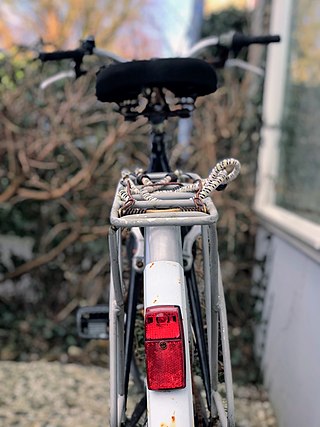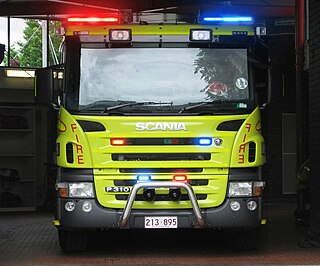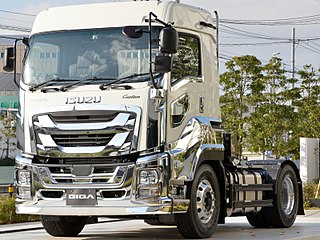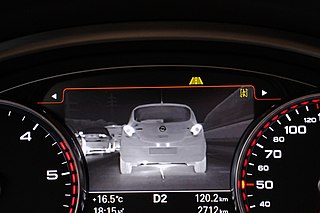
A headlamp is a lamp attached to the front of a vehicle to illuminate the road ahead. Headlamps are also often called headlights, but in the most precise usage, headlamp is the term for the device itself and headlight is the term for the beam of light produced and distributed by the device.

Tailgating is the action of a driver driving behind another vehicle while not leaving sufficient distance to stop without causing a collision if the vehicle in front stops suddenly.

An advanced driver-assistance system (ADAS) is any of a groups of electronic technologies that assist drivers in driving and parking functions. Through a safe human-machine interface, ADAS increase car and road safety. ADAS uses automated technology, such as sensors and cameras, to detect nearby obstacles or driver errors, and respond accordingly. ADAS can enable various levels of autonomous driving, depending on the features installed in the car.

Bicycle lighting is illumination attached to bicycles whose purpose above all is, along with reflectors, to improve the visibility of the bicycle and its rider to other road users under circumstances of poor ambient illumination. A secondary purpose is to illuminate reflective materials such as cat's eyes and traffic signs. A third purpose may be to illuminate the roadway so that the rider can see the way ahead. Serving the latter purposes require much more luminous flux and thus more power.

A daytime running lamp is an automotive lighting and bicycle lighting device on the front of a roadgoing motor vehicle or bicycle, automatically switched on when the vehicle's handbrake has been pulled down, when the vehicle is in gear, or when the engine is started, emitting white, yellow, or amber light. Their intended use is not to help the driver see the road or their surroundings, but to help other road users identify an active vehicle.

A motor vehicle has lighting and signaling devices mounted to or integrated into its front, rear, sides, and, in some cases, top. The devices illuminate the road ahead for the driver and increase the vehicle's visibility, allowing other drivers and pedestrians to see its presence, position, size, direction of travel, and its driver's intentions.

Emergency vehicle lighting, also known as simply emergency lighting or emergency lights, is a type of vehicle lighting used to visually announce a vehicle's presence to other road users. A sub-type of emergency vehicle equipment, emergency vehicle lighting is generally used by emergency vehicles and other authorized vehicles in a variety of colors.

Emergency vehicle equipment is any equipment fitted to, or carried by, an emergency vehicle, other than the equipment that a standard non-emergency vehicle is fitted with.

The Deutsche Bahn Class 423 EMU is a light-weight articulated electric railcar for S-Bahn commuter networks in Germany. The train has similar dimensions to its predecessor, the Class 420 EMU, but is significantly lighter and has one large passenger compartment, while that of the 420 is divided into three parts. The 423 additionally has six doors in each carriage, which is down from eight on the 420. They are numbered from 423 001 to 423 462.

The Mercedes-Benz Actros is a heavy-duty truck introduced by Mercedes-Benz at the 1996 Commercial Vehicle IAA in Hanover, Germany as the replacement for the SK. It is normally used for long-distance haulage, heavy duty distribution haulage and construction haulage. It is powered by an inline-6 diesel engine with turbocharger and intercooler. Daimler Trucks/Lorries launched the version II of the Actros in 2002, and the version III in 2007. The fourth generation of the Actros, named officially "the New Actros", launched in July 2011

The Isuzu Giga is a line of heavy-duty commercial vehicles produced by Isuzu since 1994. Outside Japan it is known as Isuzu C/E series. It was formally known as the Isuzu Heavy-Duty Truck'. Between 1994 and 2016, it was also sold in South America.

The first generation Subaru Legacy is a mid-size family car / wagon developed by Fuji Heavy Industries. The Legacy was an all new model, and was considered a notable departure from Subaru products in the past.

An automotive night vision system uses a thermographic camera to increase a driver's perception and seeing distance in darkness or poor weather beyond the reach of the vehicle's headlights. Such systems are offered as optional equipment on certain premium vehicles. The technology was first introduced in the year 2000 on the Cadillac Deville. This technology is based on the night vision devices (NVD), which generally denotes any electronically enhanced optical devices operate in three modes: image enhancement, thermal imaging, and active illumination. The automotive night vision system is a combination of NVDs such as infrared cameras, GPS, Lidar, and Radar, among others to sense and detect objects.

Headlight flashing is the act of either briefly switching on the headlights of a car, or of momentarily switching between a headlight's high beams and low beams, in an effort to communicate with another driver or drivers. The signal is sometimes referred to in car manufacturers' manuals as an optical horn, since it draws the attention of other drivers.

The Infiniti QX60, called the Infiniti JX until the 2014 model year, is a mid-size luxury crossover SUV with three-row seating produced by Infiniti, the luxury vehicle division of Japanese automaker Nissan. It is underpinned by an elongated Nissan Murano platform also used by the Nissan Pathfinder.
A number of standards specific to military organizations exist for trailer connectors, the electrical connectors between vehicles and the trailers they tow that provide a means of control for the trailers. These can be found on surplus equipment sold for civilian use.

Car controls are the components in automobiles and other powered road vehicles, such as trucks and buses, used for driving and parking.
Headlight covers are aftermarket modifications made from a variety of materials which are applied over the headlamps of a car in order to reduce the percentage of light transmitted, to tint the color of the light transmitted and/or to protect the lenses from stone chips, bug splatters, pedestrians and minor abrasions.

Trains include a variety of types of lights, for safety, illumination, and communicating train status. The most universal type of light is the headlight, which is included on the front of locomotives, and frequently on the rear as well. Other types of lights include classification lights, which indicate train direction and status, and ditch lights, which are a pair of lights positioned towards the bottom of a train to illuminate the tracks.
A car-spotting game is one that is played during a car ride, especially a road trip, where occupants of a vehicle compete to be the first to spot a car of a certain description. Many variations exist around the world. The first to call a particular target either scores points which are tracked over the course of the journey, or they earn the right to lightly punch an opponent.





















